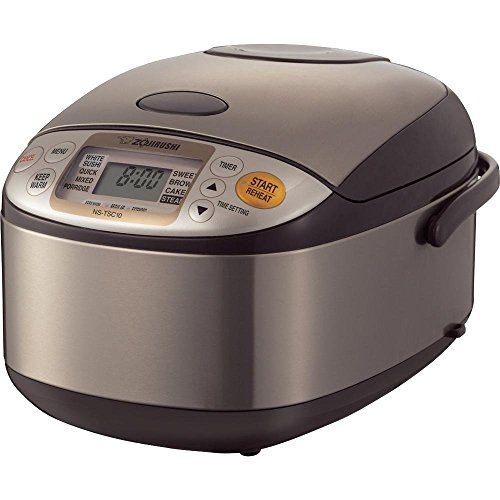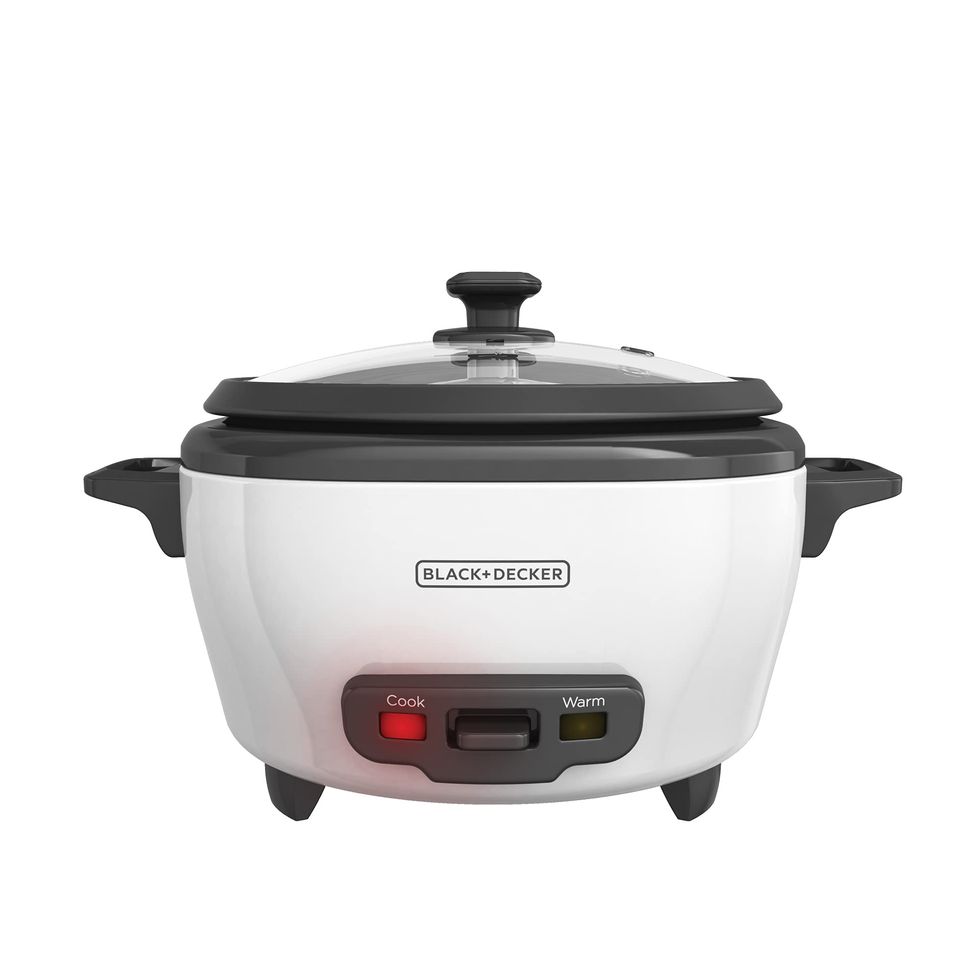What is the perfect ratio of water to rice in a rice cooker?
The golden ratio in a rice cooker is 1:1. That means 1 cup rice to 1 cup water. During our testing, we found this ratio works best for long-grain white rice, including basmati and jasmine, as well as for short-grain white rice — but check the manufacturer’s instructions since specific ratios can vary based on the model.
While almost all rice cookers come with a measuring cup, some have markings on the cooking pot so you always know how much rice and water to add, no matter the type of rice and how much you start with. Keep in mind that rice cooker cups are typically smaller than your standard measuring cup. They usually measure 3/4 cup, which doesn’t make a difference when it comes to ratios, but should be taken into account when following a standard recipe.
How to cook brown rice in a rice cooker
The general ratio brown rice is 1 cup rice to 2 1/4 cups water, using our foolproof method above.
How long does it take to cook rice in a rice cooker?
That depends on a few factors: how much rice you start with, the type of rice and the rice maker model. In general, though, count on 20 to 30 minutes for 1 cup of white rice. Allow for more time for larger amounts of rice and for varieties that are less hulled, such as brown rice (45 to 50 minutes). Luckily, you don’t have to hover around the machine, waiting to turn it off — the rice cooker will automatically stop cooking when the rice is done.
How do rice cookers work?
Add rice and water to the cooking pot, select the corresponding program (if available on your model), such as “white rice” and press the start button. It’s that simple! Pro tip: Before closing the lid, stir everything together and spread the rice so it’s level — this will help it cook more evenly. The machine will automatically stop cooking once all the water boils off and the temperature starts to inch above 212°F. Cooking times vary based on the type of rice and amount being made. We recommend letting the rice sit for 5 to 10 minutes after the program completes so it can gently finish cooking and let any excess liquid evaporate.
How do I cook 2 cups of rice in a rice cooker?
Let the manufacturer’s instructions be your North star: Follow the ratios they suggest. Our general rec for long-grain white rice is a ratio of 1:1 so for 2 cups of rice, add 2 cups of water.
Following our ratio for brown rice (1:2 1/4), you would start with 2 cups of brown rice then add 4 ½ cups of water.
How do I make fluffy rice in a rice cooker?
The best way to make fluffy rice in a rice cooker is to let the cooked rice sit undisturbed in the cooking pot, with the lid on, for 10 minutes after cooking. Think of it as beauty rest that will let the rice gently absorb excess water without overcooking. It also gives the grains a chance to cool slightly and firm up a bit. After 10 minutes, fluff the rice, layer by layer, with a rice paddle — an essential tool for rice cooker pots that are nonstick. (Metal utensils can scratch the bottom or sides.) Some rice paddles are dimpled, which helps prevent the rice from sticking.
Why is my rice sticky?
Cooked rice can feel sticky for a couple of reasons: too much water may have been used and/or the rice may not have been rinsed before cooking.
Rinsing rice before cooking is a must to wash off excess starch. Otherwise, the cooked starch will create a sticky consistency, instead of the coveted fluffy, separate grains. For best results, rinse the rice under water until the water runs clear. You can rinse the rice in a fine-mesh sieve, gently swirling the grains under running water. Or skip the strainer and rinse the rice directly in the cooking pot before cooking: Simply place the rice in the cooking pot and fill it with enough water to cover. Gently swirl the grains and pour off the starchy water. Repeat until the water is clear, about three rinses should do the trick.
How do I reduce the chance of rice cooker splatter and spillover?
Sometimes, rice cookers may splatter due to our old enemy: starch, which builds up in the machine. To prevent this, be sure to rinse the rice before cooking and stay within the maximum capacity guidelines for the rice cooker. Adding fat, like butter or oil, to the cooking pot with the rice also helps mitigate sputtering. Another way to prevent foam from spilling out of the vents is to cook less rice at a time.
How do I flavor my rice before and after cooking?
The easiest way to add flavor to rice is to swap out the water for the same amount of broth or stock. We recommend using unsalted versions to keep the sodium levels in check. You can also add herbs and spices to the cooking pot before cooking, as well as other aromatics, such as sautéed onions or garlic. If you’d like to season your rice with salt, start with a small amount before cooking then sprinkle with more to taste afterward to avoid going overboard.
When rice is cooked, feel free to zhush it up with spices or a touch of acid, like lemon juice. You could also stir in chopped fresh herbs or vegetables. For a sweet-savory take, try chopped fruit, like pineapple or mango.
What else can I use my rice cooker for?
Rice cookers can be used for all types of rice, including white, brown, long-grain, short-grain, jasmine, basmati — even wild rice. They can also cook different grains, like barley and oatmeal, as well as quinoa. Just be sure to adjust the water ratio accordingly, especially if your rice cooker doesn’t have multiple settings. Rice cookers are also clutch for all-in-one meals: layer chopped veggies or protein on top of the rice before cooking and dinner is done with the push of a button. Some even come with racks and/or baskets that allow for steaming.





